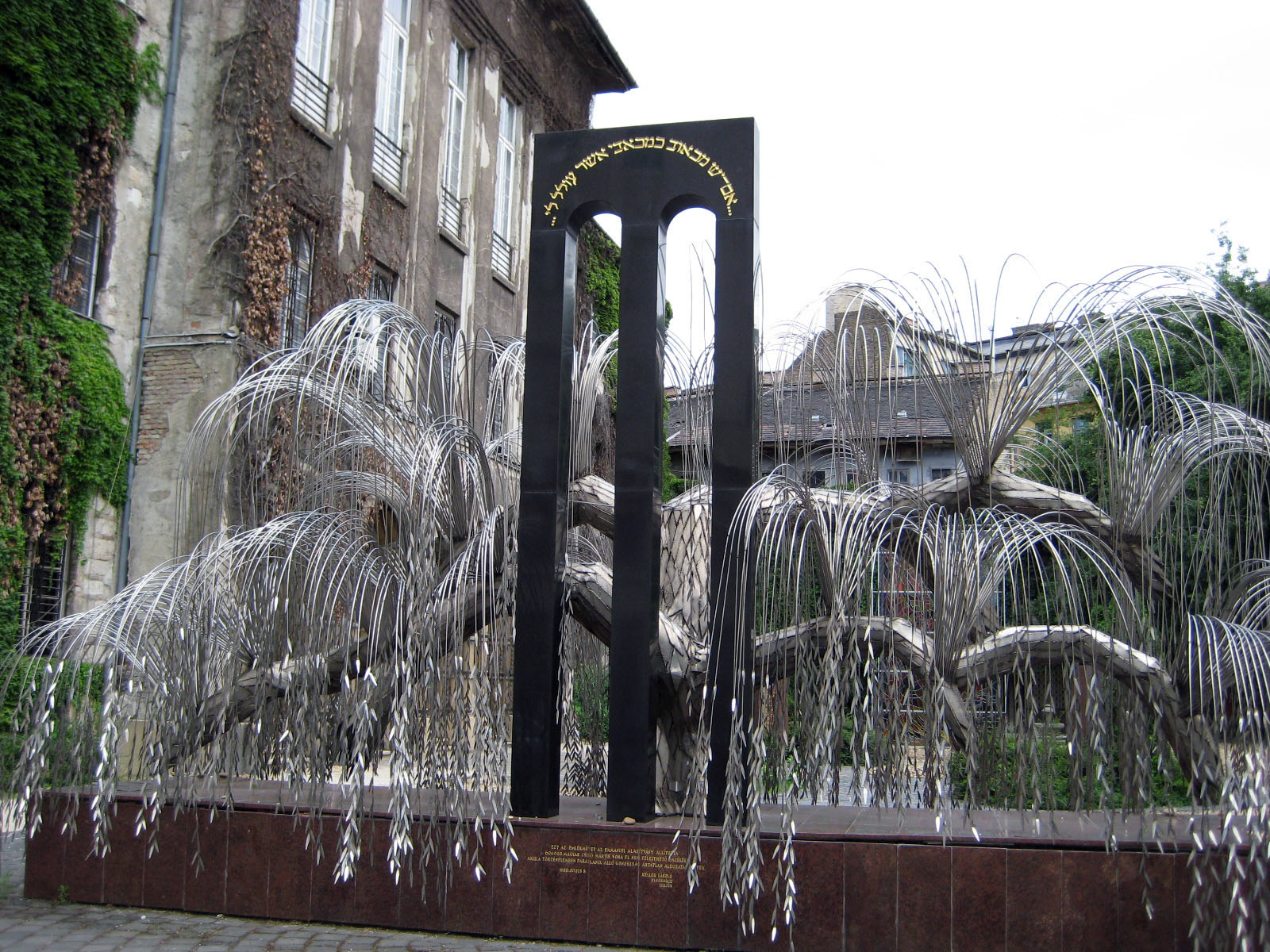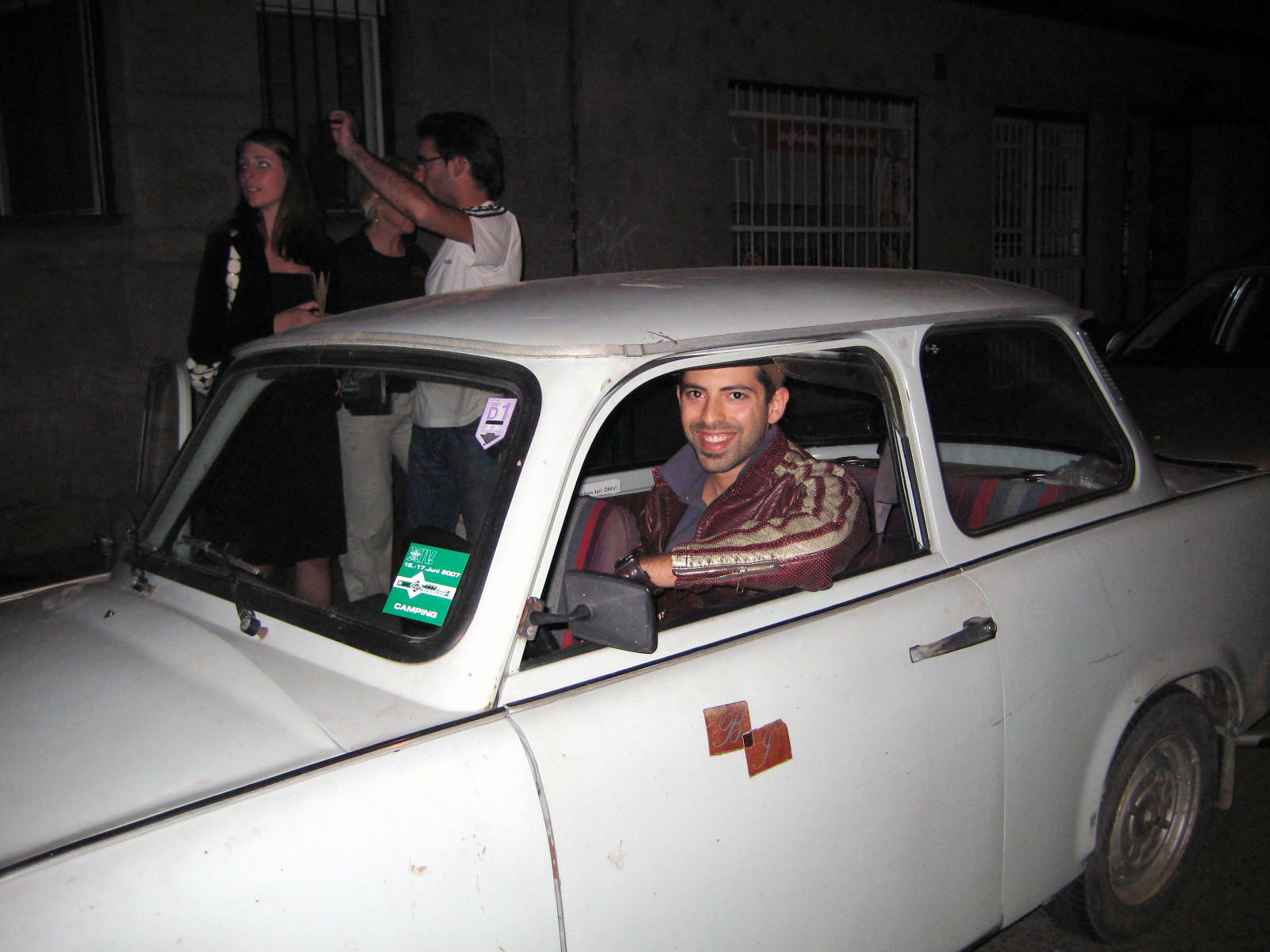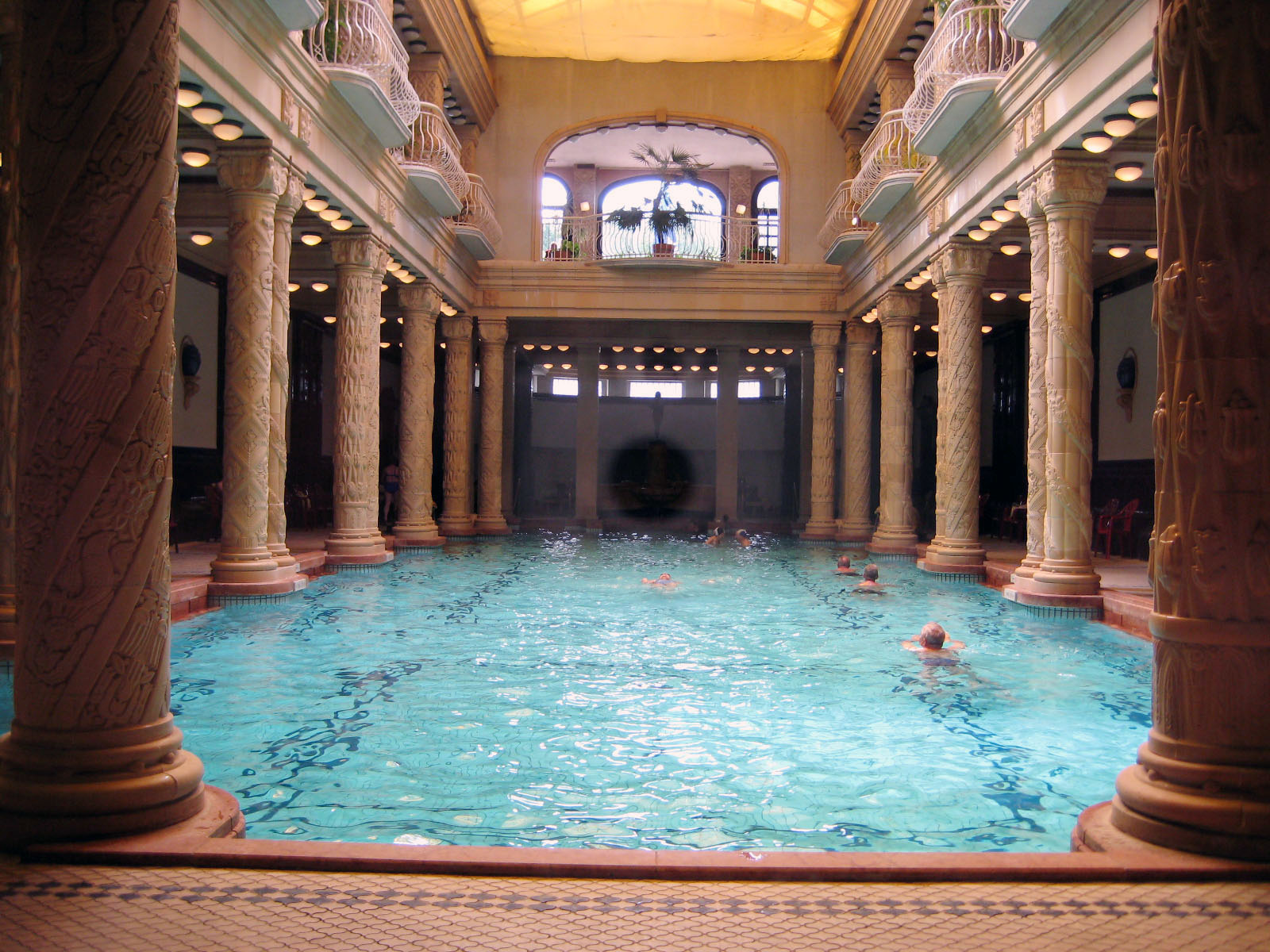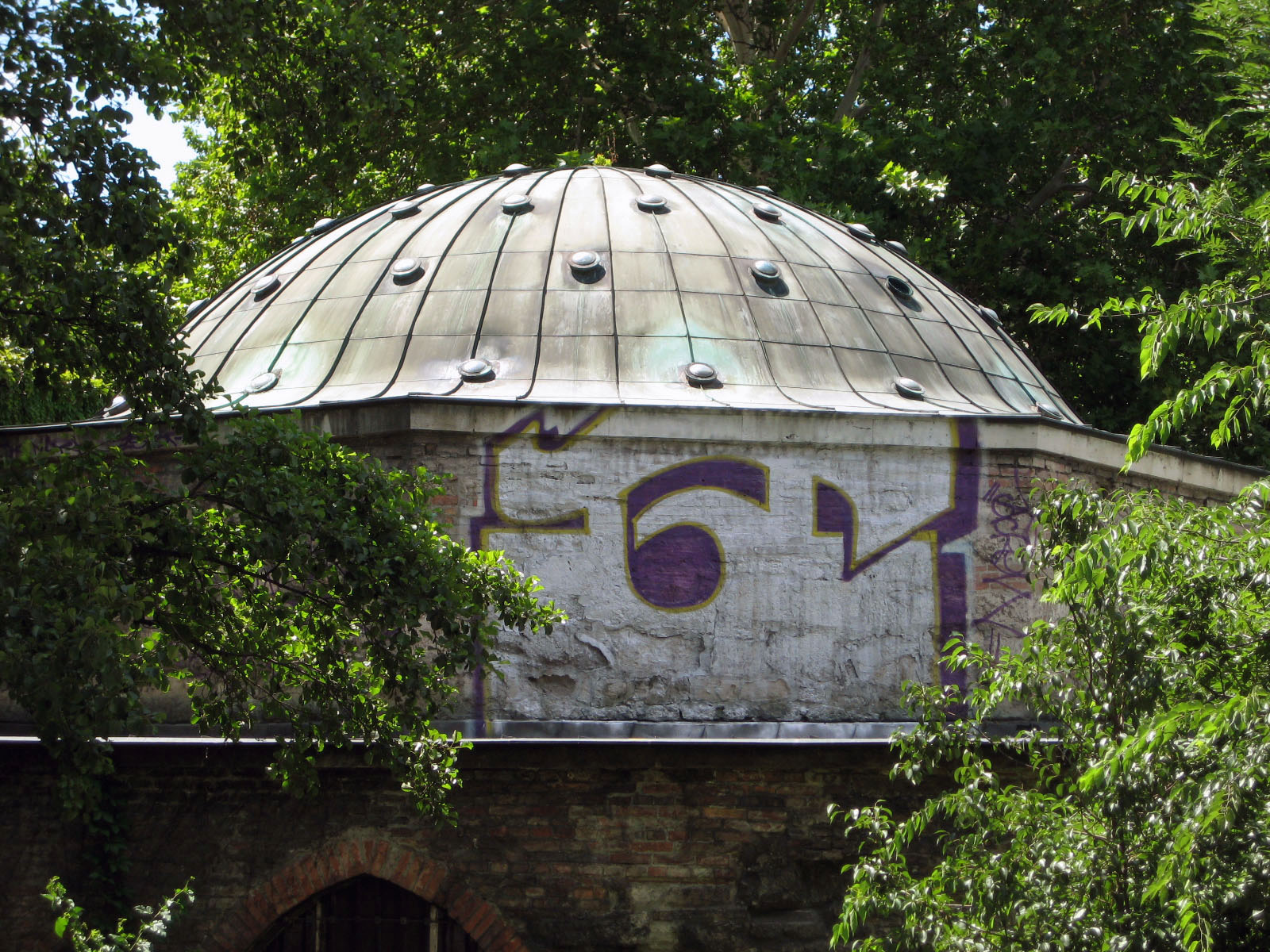 We’re staying on the Buda side of the river. Buda and Pest were joined as one city in 1873. We checked into the Art-otel, a group of old houses connected together to make a modern style hotel. The rooms are enormous. The first one we checked into was so big and cavernous we actually asked for a smaller one. That was a first.
We’re staying on the Buda side of the river. Buda and Pest were joined as one city in 1873. We checked into the Art-otel, a group of old houses connected together to make a modern style hotel. The rooms are enormous. The first one we checked into was so big and cavernous we actually asked for a smaller one. That was a first.
The hotel is very close to the Chain Bridge, the showpiece of the bridges across the Danube. This was the first bridge built across the Danube linking Pest and Buda, but almost immediately after the bridge opening celebration, it was almost blown up in the 1849 revolution for independence from the Austrian Hapsburgs. Luckily the explosives never detonated and the bridge was spared for another 96 years until the Germans blew it up in 1945. The Germans bombs were unfortunately a bit more reliable.
There’s a great story about the the bridge. A little after the bridge opening, someone pointed out that the lions posed at both ends were sculpted without tongues. The sculptor, Janos Marschalko, was ridiculed so badly, he jumped into the Danube and drowned. Even through we couldn’t see them, supposedly the lions do have tongues. They just aren’t visible from the viewing angle where everybody looks at them. As for Marschalko jumping into the Danube? Not true. He lived on for another 40 or so years, and the only message he sent to his critics was “Your wife should have a tongue just as my lions have, and woe will be unto you!”
The Pest side of the river is much grander than the older, more relaxed Buda side. Around 1867, the Hapsburgs remodeled Pest in the image of Vienna with grand boulevards and great squares. The city’s café society rivaled Paris before the two great wars.
On our first walk across the chain bridge when came upon the Szent Istvan (St Steven) Basilica, the religious center of the city. It was King Istvan (crowned in 1000 AD) who ruthlessly forced the Maygars into a Christian people. He died in 1038 and was canonized by the church in 1083, which is around the same time his mummified clenched right fist appeared. This right fist of the Right Arm of the Lord wandered around Transylvania and Dubrovnik before returning to Budapest in 1771. It disappeared for a year in 1944, but it in 1945 it came back home, and when it’s not paraded through the streets during holy festivals, it rests in a large silver reliquary in the Szent Istvan (St Steven) Basilica. It’s very weird.
 From the Basilica we walked a short distance over to Great Tobacco Synagogue on Dohany Street; Dohany in Hungarian means Tobacco. With a seating capacity of 3,000, it’s the second largest synagogue in the world. Theodore Hertzl, the father of Zionism, celebrated his Bar Mitzvah here. The 5,000 tube organ, built in 1859, was played on by Franzt Liszt and Camille Saint-Saens.
From the Basilica we walked a short distance over to Great Tobacco Synagogue on Dohany Street; Dohany in Hungarian means Tobacco. With a seating capacity of 3,000, it’s the second largest synagogue in the world. Theodore Hertzl, the father of Zionism, celebrated his Bar Mitzvah here. The 5,000 tube organ, built in 1859, was played on by Franzt Liszt and Camille Saint-Saens.
The synagogue was pretty badly damaged from the war and the Soviet occupancy. But in 1991, when freedom came to Hungary, so did a lot of money, most of it from a foundation set up by Tony Curtis. His father used to attend the old Tobacco Synagogue before emigrating the US in the 1920s. Prior to 1994, there were about 250,000 jews living in Budapest. Over 100,000 were killed during the Holocaust. But since the liberation in 1991, the jewish population is back on the rise. Currently around 90,000, it’s now one of the largest jewish communities in Europe.
 Behind the church is a small park named after Raoul Wallenberg, the Swedish diplomat who helped over 100,000 Budapest jews escape the Nazi terror. The centerpiece of the park is a metal sculpture of a weeping willow. Each willow leaf is inscribed with the name of one who perished in the holocaust.
Behind the church is a small park named after Raoul Wallenberg, the Swedish diplomat who helped over 100,000 Budapest jews escape the Nazi terror. The centerpiece of the park is a metal sculpture of a weeping willow. Each willow leaf is inscribed with the name of one who perished in the holocaust.
The Great Market Hall was designed and built by Gustave Eiffel. We love food markets; the colors, the smells, even the names are exotic. The first floor of the hall is filled with vegetables, meats, tokaji, caviar, paprika and pastries. There isn’t much fish in Hungary. Afterall it is a landlocked country. Most of the fish is from streams and rivers and mountain lakes
 The top floor houses crafts from the country, souvenirs (probably made in China) and hot food tables with sausages, stuffed cabbage, goulash, chicken paprikash, Hungarian wine and beer by the glass and a lot of other local favorites.
The top floor houses crafts from the country, souvenirs (probably made in China) and hot food tables with sausages, stuffed cabbage, goulash, chicken paprikash, Hungarian wine and beer by the glass and a lot of other local favorites.
It all smells like my grandmother’s kitchen. For both of us, the best part of the Great market was the hot (directly from the oven) retesek (strudel). I can’t begin to tell you how delicious they were. The choice was apple or raisin and spices. We sampled both, many times.
The funicular up to the castle hill is a short walk from our hotel. It’s not really a difficult walk up to the castle, but any chance to take a funicular ride is worth the time and the money. It’s a great view of the chain bridge and the river.
The Old Town and Buda Castle is a strange mixture of 15th through 20th century architecture. The remains of the 13th castle of King Béla IV is somewhere up here but no-one seems to know exactly where it was. The Ottomnan turks captured it in the early 16th century, but when the Hungarians finally booted the Turks out in 1686, most of the medieval castle was destroyed. The Turks stored their munitions in one of the Towers, and when it was hit by a bomb, the explosion was so big, it killed 1500 Turkish soldiers, and caused a tidal wave on the Danube that washed away artillery batteries on the opposite shore. The Hapsburgs finally razed the remains in 1715 and built the current palace which looks more like a Parliament building than the Budapest Parliament building. Calling it the Castle seems very silly.
 The Fisherman Bastion has the best views overlooking the river to the Pest side and looks more like a castle than the Buda Castle. It’s a beautiful nod to gothic and neo-romanesque architecture and looks like it’s been there for centuries, even though it was built in the early 1900’s.
The Fisherman Bastion has the best views overlooking the river to the Pest side and looks more like a castle than the Buda Castle. It’s a beautiful nod to gothic and neo-romanesque architecture and looks like it’s been there for centuries, even though it was built in the early 1900’s.
Old Town is filled with quaint old winding streets, museums and beautiful medieval squares.The centerpiece is the Matthias Church.
Matthias Corvinus (Matthias the Just), was married here twice. His second wife, Beatrice (daughter of the King of Naples) introduced garlic and onions to the local cuisine. Matthias was 15 when he was elected King of Hungary in 1458. A patron of the arts, he spoke Hungarian, Romanian, Croatian, Latin, German and Czech, and was victorious in several wars against the Ottomans. Vlad III Dracula, the Prince of Wallachia was one of his vassals and military captians. Unfortunately though, King Matthias left no legitimate heirs. The country fell apart after his death, culminating with the 1526 Battle of Mohacs and annihilation of the Hungarian army by the Turks under Suleiman the Magnificent. The Hungarians say “when Matthias died, all truth died with him”.
 Dating from the 11th century, the Church is a bizarre mix of Gothic and Byzantine, and the decoration style looks like bad wallpaper from the 1950s. Gretchen says as a child, her parents had drapes with the same pattern.
Dating from the 11th century, the Church is a bizarre mix of Gothic and Byzantine, and the decoration style looks like bad wallpaper from the 1950s. Gretchen says as a child, her parents had drapes with the same pattern.
We hiked through the Old Town and down to Margret Island. It’s a long walk.. The island is filled with jogging trails, fountains, open air theatres and well manicured gardens. When the Turks occupied the city, the Pasha kept his horses and women of “ill repute” on the island. It’s also a place where the locals go to sit on the embankment and sunbathe naked, a real treat those driving across the bridge. The island is named after the Margret, the daughter of King Bela IV. Béla made a promise that if the Monghol horde was defeated, he would build a convent to the Blessed Virgin and donate to it his infant daughter. The Hungarians didn’t really defeat the Monghols. Ogedai Khan, the son of Genghis Khan, died (on November 11,1241), and according to Monghol law, the Princes had to go back home and fight for the right to be the next leader. But none the less, they were gone and Bela kept his promise. In 1243 he delivered his infant daughter Margret to the island convent and there she stayed till her death in 1271. She was 28 years old. Margret was famous for both her miraculous cures of the sick and for never washing herself above her feet. The writers of the Bradt Guide (highly recommended) wrote that “her greatest achievement was in persuading people to let her near enough to heal them”.
 Crossing the Margret Bridge, over to the Pest side we walked to Andrassy Avenue, a grand Parisian style boulevard of 19th century neo-renaissance mansions. The mansion at #60 Andrassy has been recently renovated into the Terror Museum, a remarkable installation retelling the horrors of the both fascist and communist regimes from 1944-1956.
Crossing the Margret Bridge, over to the Pest side we walked to Andrassy Avenue, a grand Parisian style boulevard of 19th century neo-renaissance mansions. The mansion at #60 Andrassy has been recently renovated into the Terror Museum, a remarkable installation retelling the horrors of the both fascist and communist regimes from 1944-1956.
It’s a frightening memorial to the victims. In 1940, the Hungarian Arrow Cross Party (the Nazi equivalent in Hungary) made their headquarters in this building and called it “The House of Loyalty”. The basement was converted into a brutal prison of small concrete cells. Under Nazi rule Hungary lost over 1 million people. When the Soviets took over in 1945 the State Security Police operated out of the same building until 1956. It was pretty much the same terror. By the end of the Soviet captivity, close to 700,000 Hungarians were deported to the Gulag work camps or died from ethnic cleansing.
The installation includes a Nazi tank, a soviet staff car (with plush red velvet seats emblazed with the hammer and sickle), historical film of the occupations and interviews with survivors, Arrow Cross, Nazi and Soviet uniforms and artifacts, torture tools and devices, the basement cells and the names of those who perished. It’s a very moving exhibit and highly recommended.
 My nephew Justin is here. He and a group of international friends are fixing up 3 old East German Trabants to drive from Budapest to Cambodia in an effort to raise the awareness and money for Cambodian street children. The trek begins on July 15th. It’s a pretty ambitious adventure. These are old 2-stroke engines with a cruising speed of 60km/hr. It’s like taking a 15,000 mile ride on a lawn mower. And that’s just the beginning of the challenges. At dinner with Justin and 4 of the Trabant trek team, they told us about the latest set back. The Chinese government wanted them to pay $13,000 just to drive through. The fee started at $6,000 but once more Chinese officials got involved, the price went up; more beaks to feed.
My nephew Justin is here. He and a group of international friends are fixing up 3 old East German Trabants to drive from Budapest to Cambodia in an effort to raise the awareness and money for Cambodian street children. The trek begins on July 15th. It’s a pretty ambitious adventure. These are old 2-stroke engines with a cruising speed of 60km/hr. It’s like taking a 15,000 mile ride on a lawn mower. And that’s just the beginning of the challenges. At dinner with Justin and 4 of the Trabant trek team, they told us about the latest set back. The Chinese government wanted them to pay $13,000 just to drive through. The fee started at $6,000 but once more Chinese officials got involved, the price went up; more beaks to feed.
This was our day to visit the Hungarian National Museum. The current installation is about the Monghol invasion from the 734 AD Monghol leader Kulte Gin to the time of the Khans and in to contemporary Mongolia. Since we just came here from China, it kind of made sense to follow the exploits of the Monghols. At the height of the their empire it stretched from China and Mongolia through Russia, Siberia, Persia, Central Asia (Turkey) and eastern Europe. There was the Golden Horde in Russia, the Ilkanate in Persia under Hulegu Khan, the Cayatai in Turkey and Central Asia and the Yuan Dynesty under Kublai Khan in China. Nothing could stop them. They overpowered anything put in their path; tree, rock and human.
In 1241 at the battle of Mohi, 10,000 Hungarians were slaughtered, most of them killed as they retreated from the battle and ran for home. When Ogedai Khan died in 1242 and the Monghols left, the Hungarians fortified their defenses and waited. Sure enough, 42 years later, the Monghols returned. But this time the armies of Hungary, Slavonia, Austria and Transylvania were much stronger.
The Szabadsag bridge (The Liberty Bridge) leads back to the Buda side and directly into the Gellert Hotel and spa. This bridge was opened in 1896 by the Austrian Emperor Franz Joseph. He even inserted the last rivet into Pest abutment. Being the Emperor, the ceremonial rivet was silver. Being the people of Budapest, it was almost immediately stolen. There was no great love for the Austrian Emperor.
 The Gellert Thermal Baths might have once been the most beautiful in all of Budapest but they’ve hit hard times these days. The bones of the Art Nouveau building are still there but the skin is sagging and bruised. However, the magical mineral hot spring water filled with medicinal quantities of calcium, magnesium, alkalis, chloride, sulfate, and fluoride still flow under the hotel and you can still get treatments here ranging from Thai massage to dental surgery.
The Gellert Thermal Baths might have once been the most beautiful in all of Budapest but they’ve hit hard times these days. The bones of the Art Nouveau building are still there but the skin is sagging and bruised. However, the magical mineral hot spring water filled with medicinal quantities of calcium, magnesium, alkalis, chloride, sulfate, and fluoride still flow under the hotel and you can still get treatments here ranging from Thai massage to dental surgery.
 With countless hot springs flowing under the city, there are no shortage of thermal baths. On our way over to Margret Island we stopped by the The Kiraly Baths to have a look, but they were closed for the summer.
With countless hot springs flowing under the city, there are no shortage of thermal baths. On our way over to Margret Island we stopped by the The Kiraly Baths to have a look, but they were closed for the summer.
These are the oldest baths in the city, built in the late 16th century under the Turkish rule. They are also one of the few open to both sexes and Kiraly was a hole of hot steaming sex during the wild 60’s 70’s and 80’s.
Gretchen had a facial massage at the baths in the Gresham Palace (now the Four Seasons Hotel) and said it was one of the best she ever had. By the way, even if you don’t partake of the baths, you can’t escape the medical properites of the water. The city water, bottled water, coffee, tea, fruit and veggies; they’re all filled with the magic elixer.
When I visited this city back in 1990, there was a layer of grey grime covering the city and a dark orange haze from the pollution. The coffee was undrinkable and the only wine you could get was “Bulls Blood”. The cafes were shabby and the atmosphere was really oppressive. The city has completely changed. It’s bright and beautiful and the renovation doesn’t stop. New buildings are going up and old building are getting renovated. Pedestrian zones like the Vaci Utca are filled with fashion outlets, tourist shops, outdoor cafes and restaurants offering check out the cabernets from the Jammertal region in the south. And the food is classic; goulash, chicken paprikash, strudel and some of the best crispy skin duck we’ve ever tasted. It’s a very exciting time and a great time to visit.
Compared to the rest of Europe, Budapest is a very affordable city, about 35% less than Paris or Rome. Even the Hungarians are starting to lighten up and enjoy life. Something that hasn’t happened to them in over 480 years, since the 1526 Battle of Mohacs, when the Turks wiped out over 14,000 Hungarians in just the first battle. It’s known as the defining moment of the fall of Hungary. Over 1,000 nobles were killed, including Hungary’s King Louis II. Mohacs was pretty much the end of an independent Hungary. Even now when things get really bad, people will console themselves and say “it was worse at Mohacs”.
By the time the Turks were run out of the country (160 years later) the coffers of Hungary were empty from paying conscripted armies and the Austrian Hapsburgs moved in. Hapsburg blood was married into the Hungarian royal line since the early 1500’s and it was easy for them to claim the throne. There were a few attempts at getting the country back. In 1848, the poet Sándor Petofi mobilized crowds into the revolution known as the War of Independence, the War that almost blew up the Chain Bridge in 1849. They were defeated.
It took World War I to defeat the Hapsburgs in 1918. Then in 1919, they lost a war with Romania. Early socialist control gave way to the Arrow Cross Nazis. Towards the end of World War II, Budapest was destroyed by British and American air raids, retreating Nazis and advancing Soviet troops. Most of the city was reduced to rubble. More than 38,000 civilians lost their lives during the fighting while many of the residents of the city hid away in cellars for close to six months, surviving on dead horses for food.
The Soviets weren’t any better than the Nazis. Matyas Rakosi, also known as “Little Stalin”; killed and tortured more people than any other ruler of Hungary. He was so outrageous even the Soviets were afraid of him and booted him out in 1953.
In 1956, what started out as a peaceful demonstration got out of control and turned really bad. The Soviets sent in 150,000 troops and 2,500 tanks to squash the rebellion. Thousand of people caught in the streets were slaughtered. As a result of the 1956 uprising, the Soviets opened the borders and told the Hungarians, “if you don’t like it here, leave.” And so they did. Nearly a quarter of a million people left the country.
In 1990, Gabor Demszky was elected the mayor of Budapest. He just won his 5th term in 2006. By the end of this term he will have been mayor for 20 years, the longest anyone has held office in the post Soviet countries since the fall of Communism. He’s been doing a great job. It’s the first time the people have been happy since King Matthias died in 1490.
Oh, one more thing. For those of you curious where the word “hello” came from, it was here in Budapest. Puskas Tivadar invented the telephone exchange here in 1877. On testing his invention, he called out “Hallom”, meaning I can hear you in Hungarian. And so we now say “hello” instead of “Watson, come quick.”
You must be logged in to post a comment.